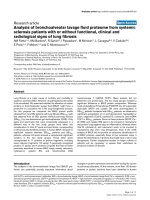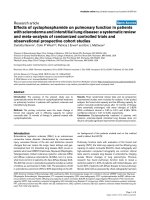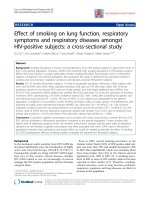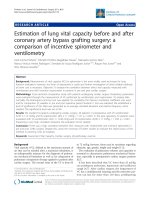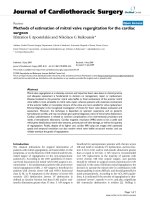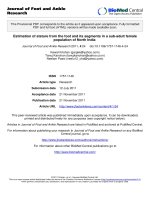Báo cáo y học: "Estimation of lung vital capacity before and after coronary artery bypass grafting surgery: a comparison of incentive spirometer and ventilometry" pps
Bạn đang xem bản rút gọn của tài liệu. Xem và tải ngay bản đầy đủ của tài liệu tại đây (703.81 KB, 5 trang )
RESEARCH ARTICLE Open Access
Estimation of lung vital capacity before and after
coronary artery bypass grafting surgery: a
comparison of incentive spirometer and
ventilometry
Areli Cunha Pinheiro
1
, Michelli Christina Magalhães Novais
1
, Mansueto Gomes Neto
1
,
Marcus Vinicius Herbst Rodrigues
2
, Erenaldo de Souza Rodrigues Junior
1,3,4
, Roque Aras Junior
3,4
and
Vitor Oliveira Carvalho
2*
Abstract
Background: Measurement of vital capacity (VC) by spirometry is the most widely used technique for lung
function evaluation, however, this form of assessment is costly and further investigation of other reliable methods
at lower cost is necessary. Objective: To analyze the correlation between direct vital capacity measured with
ventilometer and with incentive inspirometer in patients in pre and post car diac surgery.
Methodology: Cross-sectional comparative study with patients undergoing cardiac surgery. Respiratory parameters
were ev aluated through the measurement of VC performed by ventilometer and inspirometer. To analyze data
normality the Kolmogorov-Smirnov test was applied, for correlation the Pearson correlation coefficient was used
and for comparison of variables in pre and post operative period Student’s t test was adopted. We established a
level of ignificance of 5%. Data was presented as an average, standard deviation and relative frequency when
needed. The significance level was set at 5%.
Results: We studied 52 patients undergoing cardiac surgery, 20 patients in preoperative with VC-ventilometer:
32.95 ± 11.4 ml/kg and VC-inspirometer: 28.9 ± 11 ml/Kg, r = 0.7 p < 0.001. In the post operatory, 32 patients were
evaluated with VC-ventilometer: 28.27 ± 12.48 ml/kg and VC-inspirometer: 26.98 ± 11 ml/Kg, r = 0.95 p < 0.001.
Presenting a very high correlation between the ev aluation forms studied.
Conclusion: There was a high correlation between DVC measures with ventilometer and incentive spirometer in
pre and post CABG surgery. Despite this, arises the necessity of further studies to evaluate the repercussio n of this
method in lowering costs at hospitals.
Keywords: Assessment Vital Capacity, Cardiac surgery, physiotherapy, exercise
Background
Vital capacity (VC), defined as the maximum amount of
air that can be exhaled after a maximum inhalation, is
an indispensable measure for the diagnosis of pulmon-
ary mechanical limitation as well as for adequation of
pulmonary reexpansion therapy applied to patients after
car diac surgery. The normal value of the VC is from 65
to 75 ml/kg, however, there may be variations regardi ng
ethnicity, age, gender, height and weight [1-5].
The evaluation of pulmonary volumes and capacities is
essential to chara cterize pulmonary mechanical limita-
tion, especially in postoperative cardiac surgery patients
[6,7].
It has been described that VC lower than 25 ml/Kg
can predispose atelectasis, hypoxemia and inefficient
cough [6,7]. After cardiac surgery, the impairment of
VC has a multifactorial meaning and the restrictive pat-
tern can last for more than 116 days, predisposing
* Correspondence:
2
Instituto do Coração do Hospital das Clínicas da Faculdade de Medicina da
USP (InCor HC-FMUSP), São Paulo, Brazil
Full list of author information is available at the end of the article
Pinheiro et al. Journal of Cardiothoracic Surgery 2011, 6:70
/>© 2011 Pinhe iro et al; licensee BioMed Central Ltd. This is an Open A ccess article distributed under the terms of the Creative Commons
Attribution License ( which permits unrestricted u se, distribution, and reproduction in
any medium, provided the original work is properly cited.
atelectasis and post operatory complications [8-16]. In
order to obtain pulmonary volumes and capacities,
spirometry and ventilometry are the most used techni-
que s in clinical practice, nevertheless, both methods are
very costly and not always available in hospitals
[3,5,17-20].
Due to its low cost, incentive spirometers a re widely
used in hospitals. They are used for treating and preven-
tive purposes regarding pulmonary complications. This
device works with v isual stimulation to deep inspirat ion
and is largely used by patients in post operatory periods
of abdominal and thoracic surgery [21,22].
Due to the importance of accessing VC in patie nts
who underwent cardiac surgery and considering the
high cost of ventilometers and spirometries, arises the
necessity of an inexpensive alternative method w hich
can reflect in a reliable manner the VC.
The aim of this study was to evaluate the incentive
spirometers as a method of assessment VC in patients
in pre and post coronary artery bypass grafting (CABG)
surgery.
Methods
Studied population
This study was accomplished in a tertiary cardiac hospi-
tal with a group of patients in pre operatory and
another group in the 5
th
post operatory day of CABG
surgery. Patients with smoking h istory, pulmonary dis-
eases, extracorporeal circulation time higher than 150
minutes, intolerance and/or difficulties in understanding
the technique were excluded.
This protocol wa s approved by the Ethical Committee
of our institution. All patients provided informed con-
sent prior to participation.
Study design
This cross-sectional prospective study was designed to
study the direct vital capacity (DVC, ml/Kg) measured
by ventilometer and Incentive spirometer before and
after CABG surgery.
The execution order of DVC techniques measured
with ventilometer and incentive spirometer were rando-
mized through sealed envelopes. All participants were
oriented regarding the methodology to be used in each
measurement. In orde r to avoid bias in the results pre-
sented, data collection was made by only one researcher.
DVC Measurement with ventilometer
In order to measure DVC with ventilometer, the indivi-
duals were placed in a sitting position with thorax in a
vertical way in approximately 90°. A ve ntilometer (Fer-
raris
®
) was used with a trachea in its shortest length,
connected between the ventilometer and a hard flat
mouthpiece. A nasal clip was used to avoid air escape
by the nose.
23
Then, the patients performed deep
inspiration until total pulmonary capacity followed b y
continuous and slow expiration until residual volume.
The technique was applied three t imes and the highest
volume was considered.
DVC Measurement with incentive inspirometer
To assess DVC wi th an incentive spirometer, patients
adopted the same positioning performed by the ventil-
ometer. An inspirometer (Coach
®
)wasusedwasused
with a trachea in its shortest length, connected between
the ventilometer and a hard flat mouthpiece. A nasal
clip was used to avo id air escape by the nose. Then the
patients performed deep slow expiration until residual
volume, followed by conti nuous and deep inspiration
until total pulmonary capacity, in which VC was mea-
sured through the numerical marking of the inspirom-
eter. The technique was applied three times and the
highest volume was considered.
Statistical analysis
Descriptive statistics was applied to analyze demo-
graphic and clinical data, continuous variable informa-
tion were assessed as measures of central tendency and
dispersion and expressed asaveragesandstandard
deviation. Dichotomous or categorical variables were
evaluated with frequency measures and presented as
percentages. To analyze data normality Kolmogorov-
Smirnov test was applied. Since data was regularly dis-
tributed the correlation assessment between DVC mea-
sured with ventilometer and incentive inspirometer w as
based on Pearson correla tion coefficient [23,25]. T-stu-
den t test for independent sam ples was used to compar e
patients’ variables in pre and p ost operatory periods.
Bland-Altman plots with 95% limits of agreements were
also de rived. The assessment occurred with use of soft-
ware SPSS (Statistical Package for the Social Sciences)
for Windows (version 14.0).
Results
Fifty two patients subm itted to CABG surgery were
evaluated, 20 patients i n pre operatory (15 men) and 3 2
patients in post operatory (21 men) (table 1). In table 2
averages and DVC standard deviation patterns accom-
plished through ventilometry and spirometry in pre and
post operatory are described. The u se of incentive spi-
rometer was well tolerated and of easy comprehension
by the patients.
Analyzing the obtained data, we can observe that DVC
measures between ventilometer and inspirometer sho w
high corr elation in pre and post CABG surgery (r = 0.7
and 0.95 respectively, p < 0.01) (Figures 1 and 2).
Figure 1 demonstrates correlation between DVC
values in ml/Kg with vent ilometer and incentive
Pinheiro et al. Journal of Cardiothoracic Surgery 2011, 6:70
/>Page 2 of 5
inspirometer i n patients before CABG surgery. DVC
with ventilometer varied from 14.6 to 55.2 ml/Kg and
DVC with incentive inspirometer varied from 9.2 to
52.7 ml/Kg.
There was a correlation between DVC values in ml/Kg
with ventilometer and incentive inspirometer in patients
after CABG surgery. DVC with ventilometer varied from
9 to 66.6 ml/Kg and DVC with incentive inspirometer
varied from 7.7 to 52.8 ml/Kg (Figure 2).
In subsequent assessment a comparison of averages
before and after CABG surgery was performed and it
was observed that there were not significant disparit ies
in DVC averages analysis (Table 2).
Bland Altman plots with 95 % of agreement are shown
in Figures 3 and 4. Cronbach ’ sAlfaindexwas0.82to
pre and 0.97 to post surgery.
Discussion
The main point of this research was the positive correla-
tion between DVC measured with ven tilometer and
incentive spirometer. Furthermore, the use of incen tive
spirometer as DVC evaluation method was of easy
execution and understanding by the patient.
Nowa days, studies have been carried out with the aim
to standardize pulmonary function ways of assessment
[26,27]. The investigation of evaluation methods for pul-
monary function with high sensibility and specificity has
a great value for clinical practice, mainly when these
techniques can be applied in a practical way, in bed and
at low cost.
In literature there is an array of researches highlighting
the importance of volumes and pulmonary capacities mea-
surem ents. Chevrolet e Deleament [28] assure that VC is
an important predictor of pulmonary function because it
evaluates the mechanical ventilation necessity and success
in ventilatory weaning. Suesada et al.[29] showed that VC
was one of the variables with higher impairment after
short length hospitalization. Gregori ni et al.[23] reported
that pa tients in post operatory of cardiac surgery showed
decreased volumes and pulmonary capacities, there fore
reducing the quantity of dee p inspirations a nd c ough
effectiveness. The lessening of deep inspiration and cough
has been proposed to predispose respiratory complications
in which atelectasis is the most frequent, reaching approxi-
mately 64% of operated patients [23].
The v entilometer, as well as spirometry, is frequently
used to evaluate VC in patients with respiratory dys-
functions, however, its cost and maintenance are also
elevated [18,19]. This high cost motivates the use of
alternative ways to access VC in clinical practice [30].
Table 1 Demographic characteristics of patients in pre
and post operatory cardiac surgery
VARIABLES
N=52
PRE OPERATORY
N (%) AVERAGE ± SD
POST OPERATORY
N (%) AVERAGE ± SD
Gender
Male 15 (75%) 21 (65%)
Female 05 (25%) 11 (35%)
Age 49.7 ± 15.13 anos 49.7 ± 15.8 anos
BMI 24.8 ± 3.3 kg/m
2
25.5 ± 2.5 kg/m
2
RF 18.4 ± 6 rpm 21.2 ± 7.94 rpm
TV 717.7 ± 315.9 ml 632.2 ± 263.2 ml
MV 13.178 ± 6.422 L/min 13.278 ± 6.216 L/min
BMI: Body mass index, RF: respiratory frequency, TV: tidal volume, MV: minute
volume
Table 2 Comparison with averages and Standard
deviation variables: age, BMI, DVC through ventilometry
and spirometry in pre and post operatory groups
VARIABLES PRE OPERATORY
AVERAGE ± SD
POST OPERATORY
AVERAGE ± SD
p
Age 49.7 ± 15.13 years 49.7 ± 15.8 years 0.985
BMI 24.8 ± 3.3 kg/m
2
25.5 ± 2.5 kg/m
2
0.353
DVCV 32.95 ± 11.4 ml/Kg 28.27 ± 12.48 ml/Kg 0.304
DVCI 28.9 ± 11 ml/Kg 26.98 ± 11 ml/Kg 0.859
BMI: Body mass index, DVCV: direct vital capacity measured with ventilometer.
DVCI: direct vital capacity measured with incentive inspirometer.
Figure 1 Correlation between DVC measured with ventilometer
and incentive spirometer in pre operatory groups.
Figure 2 Correlation between DVC measured with ventilometer
and incentive spirometer in post operatory groups.
Pinheiro et al. Journal of Cardiothoracic Surgery 2011, 6:70
/>Page 3 of 5
The ratio nale of using an incentiv e spirome ter to VC
assessment is based on the fact that with ventilometer
the patient could perform a deep inspiration until his
total pulmonary capacity, followed by continuous and
slow expiration until residual volume. Wi th the incent ive
inspirometer, whic h operates through inspirations and
volumetric registrations, the individual could perform the
opposite from the ventilometer and the same air volume
would be evaluated. This connection was highly evi-
denced in the results presented on this research, since
the patients in pre and post operatory cardiac surgery
showed homogeneous values of DVC measured by ventil-
ometer and incentive spirometer (Figures 1 and 2).
The results of this present study could be used in
further investigations in order to deepen the knowl edge
about the connection between DVC measured with ven-
tilometer and incentive inspirometer.
Conclusion
There was a high correlation between DVC measures
with ventilometer and incentive s pirometer in pre and
post CABG surgery. Despite t his, arises the necessity of
Figure 3 Bland & Altman plots between Ventilometer and Spirometer pre cardiac surgery.
Figure 4 Bland & Altman plots between Ventilometer and Spirometer post cardiac surgery.
Pinheiro et al. Journal of Cardiothoracic Surgery 2011, 6:70
/>Page 4 of 5
further studies to evaluate the repercussion of this
method in lowering costs at hospitals.
Acknowledgements
The authors would like to thank the “Hospital Ana Nery - UFBA” for the
opportunity of data collection.
Author details
1
Faculdade Social, Salvador, Bahia, Brazil.
2
Instituto do Coração do Hospital
das Clínicas da Faculdade de Medicina da USP (InCor HC-FMUSP), São Paulo,
Brazil.
3
Hospital Ana Neri da Faculdade de Medicina da Universidade Federal
da Bahia (HAN-UFBA), Salvador, Bahia, Brazil.
4
Faculdade de Medicina da
Universidade Federal da Bahia, Salvador, Bahia, Brazil.
Authors’ contributions
VOC and ESRJ were involved with study design, ACP collected the data,
MGN and VOC performed the data analysis, MVHR, RAJ and MCMN were
involved with data discussion. All authors have read and approved the
manuscript.
Competing interests
The authors declare that they have no competing interests.
Received: 3 January 2011 Accepted: 12 May 2011
Published: 12 May 2011
References
1. Neder JA, Andreoli S, Castelo-Filho A: Reference values for lung function
tests. I.Static volumes. Braz J Med Biol Res 1999, 32:703-17.
2. Eaton T, Withy S, Garrett JE: Spirometry in primary care practice. The
importance of quality assurance and the impact of spirometry
workshops. Chest 1999, 116:416-23.
3. Scalan CL, Wilkins RK, Stoller : Fundamentos da terapia respiratória de
Egan. 7ª edição. Editora Manole Ltda. São Paulo 2000.
4. Rodrigues JC, Cardier JMA, Dussamra MHCF, Nakaie CMA, Almeida MB, Silva
Filho LVF, Adde FV: Provas de função pulmonar em crianças e
adolescentes. J Pneumol 2002, 28:207-221.
5. Mallozi MC: Valores de referencia para espirometria em crianças e
adolescentes, calculados a partir de uma amostra da cidade de São
Paulo. (Tese). São Paulo: Universidade Federal de São Paulo - Escola Paulista
de Medicina 1995.
6. Forgiarini LA Jr, Rubleski A, Douglas G, Tieppo J, Vercelino R, Dal Bosco A,
Monteiro MB, Dias AS: Evaluation of respiratory muscle strength and
pulmonary function in heart failure patients. Arq Bras Cardiol 2007,
89:36-41.
7. Newton-John H: Prevention of pulmonary complications in severe
Guillain-Barré syndrome by early assisted ventilation. Med J Aust 1985,
142:444-5.
8. Yavagal DR, Mayer SA: Respiratory complications of rapidly progressive
neuromuscular syndromes: Guillain-Barré syndrome and myasthenia
gravis. Semin Respir Crit Care Med 2002, 23:221-9.
9. Vargas FS, Terra-Filho M, Hueb W, Teixeira RL, Cukier A, Light RW:
Pulmonary function after coronary artery bypass surgery. Respir Med
1997, 91:629-33.
10. Guizilini S, Faresin SM, Carvalho ACC, Jaramillo JI, Alves FA, et al: Effects of
the pleural drain site on the pulmonary function after coronary artery
bypass grafting. Rev Bras Cir Cardiovasc 2004, 19:47-54.
11. Taggart DP, El-Fiky M, Carter R, Bowman A, Wheatley DJ: Respiratory
dysfunction after uncomplicated cardiopulmonary bypass. Ann Thorac
Surg 1993, 56:1123-8.
12. Renault JA, Val RC, Rossetti MB: Fisioterapia respiratória na disfunção
pulmonar pós-cirurgia cardíaca. Rev Bras Cir Cardiovasc 2008, 23:562-9.
13. Lichtenberg A, Hagl C, Harrier W, Klima U, Haverich A: Effects of minimal
invasive coronary artery bypass on pulmonary function and
postoperative pain. Ann Thorac Surg 2000, 70:461-5.
14. Giacomazzi CM, Lagni VB, Monteiro MB: Does the pain disturb the
respiratory function after open heart surgery? Rev Bras Cir Cardiovasc
2009, 24:490-496.
15. Dias CM, Plácido TR, Ferreira MFB, Guimarães FS, Menezes SLS:
Incentive
spirometry and breath stacking: effects on the inspiratory capacity of
individuals submitted to abdominal surgery. Rev Bras Fisioter 2008,
12:94-9.
16. Ropper AH: Critical care of Guillain-Barre syndrome. In Ropper AH, ed
Neurological and neurosurgical intensive care. New York, Raven Press;
1993, p371.
17. Barreto SSM: Volumes pulmonares. J Pneumol 2002, 28:83-94.
18. Boskabady MH, Keshmiri M, Banihashemi B, Anvary K: Lung function volues
in healthy non-smoking urban adults in iran respiration. JPMA 2002,
69(4):320-6.
19. Memon MA, Sandila MP, Ahmed ST: Spirometry reference values in
healltlly, now smoking, urban pakistani population. J Pak Med Assoc 2007,
57:193-5.
20. Bosoglu OK, Atasever A, Bakakoglu F: The efficacy of incentive spirometry
in patients with COPD. Respirology 2005, 10:349-353.
21. Agostini P, Calvert R, Subramanian H, Naidu B: Is incentive spirometry
effective following thoracic surgery? Interactive Cardiovascular and
Thoracic Surgery 2008, 7:297-300.
22. Rouquayrol MZ, Almeida Filho N: Epidemiologia a Saúde. 6 ed. Editora
Medsi. São Paulo 2003.
23. Aquino LM, Branco JNR, Bernardelli GF: Short-duration transcutaneous
electrical nerve stimulation in the postoperative period of cardiac
surgery. Arq Bras Cardiol 2010, 94:325-31.
24. Domholdt E: Physical therapy research; Principles and Applications. WB
Saunders Company, USA;, 2 2000.
25. Lopes AA: Medicina baseada em evidencias: a arte de aplicar o
conhecimento cientifico na prática clínica. Rev Assoc Med Bras 2000,
46:285-288.
26. America Thoracic Society/European Respiratory Society. ATS/ERS
statement on respiratory muscle testing. Am J Respir Crit Care Med 2002,
166:518-624.
27. Sociedade Brasileira de Pneumologia e Tisiologia. Diretrizes para testes
de função pulmonar. J Pneumol 2002, 28:S1-S238.
28. Chevrolet JC, Deleamont P: Repeated vital capacity measurements as
predictive parameters for mechanical ventilation need and weaning
success in Guillain-Barré syndrome. Am Rev Respir Dis 1991, 144:814-8.
29. Suesada MM, Martins MA, Carvalho CR: Effect of short-term Hospitalization
on functional capacity in patients not restricted to Bed. Am J Phys Med
Rehadil 2007, 86:455-62.
30. Ropper AH: Acute inflammatory post infectious polyneuropathy. In
Neurological and Neurosurgical Intensive Care. Edited by: Roppere AH,
Kennedy SF. Gaitherburg, MD Aspen Publications; 1991:.
doi:10.1186/1749-8090-6-70
Cite this article as: Pinheiro et al.: Estimation of lung vital capacity
before and after coronary artery bypass grafting surgery: a comparison
of incentive spirometer and ventilometry. Journal of Cardiothoracic
Surgery 2011 6:70.
Submit your next manuscript to BioMed Central
and take full advantage of:
• Convenient online submission
• Thorough peer review
• No space constraints or color figure charges
• Immediate publication on acceptance
• Inclusion in PubMed, CAS, Scopus and Google Scholar
• Research which is freely available for redistribution
Submit your manuscript at
www.biomedcentral.com/submit
Pinheiro et al. Journal of Cardiothoracic Surgery 2011, 6:70
/>Page 5 of 5
